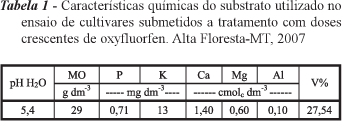Cotton agribusiness is a very important economic activity in Brazil, occupying a prominent position in the productive process of the state of Mato Grosso. For cotton crop to express its maximum productive potential, it is necessary to adopt handling techniques and agronomic practices seeking the control of weeds. For farming to stay clean and free from weed competition, chemical control is the most frequently used method. The herbicides registered for cotton crop should be applied when the culture is established in driven jet. The contact of products, such as oxyfluorfen, on the leaves may incur in plant intoxication and losses to the farmer. The objective of this work was to evaluate the effects of oxyfluorfen on five cotton cultivars at the initial development phase. The cotton cultivars were treated with 90 and 180 g ha-1 of the herbicide applied 15 and 30 days after sowing. For the analyzed variables (phytointoxication, plant height, number of leaves, plant dry mass), no difference was found among the cotton cultivars, with the smaller plants suffering more than the older plants, leading to increased damages, as doses increased.
Gossypium hirsutum; herbicide; phytointoxication; drift





